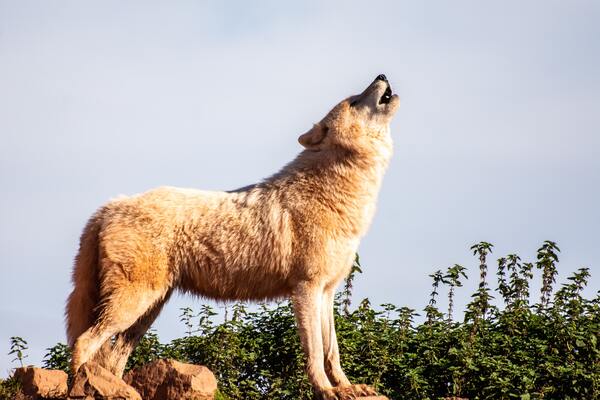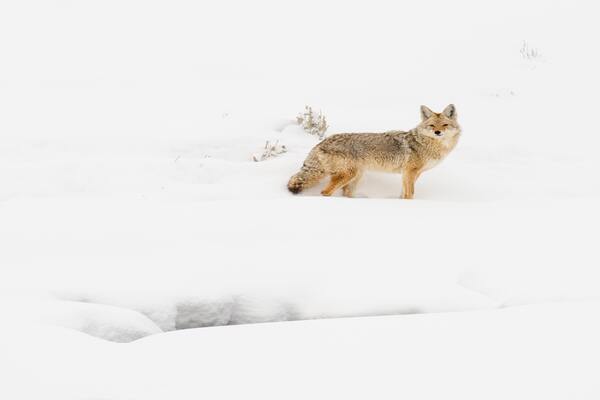You see a sizable, gray, furry animal in front of you darting across the street or along a wooded trail. Or perhaps you hear ominous howling in the night. A coyote, perhaps? Possibly a wolf. Although there are numerous parallels between wolves and coyotes, there are also clear distinctions. In this article, we will talk about the main differences between wolves and coyotes.
Wolf VS. Coyote
Wolves and coyotes sport many similarities in appearance. Both of them are medium- to large-sized canine-like creatures. The majority of their coats are gray, with sporadic patches of black, white, red, or brown. They are both carnivores that hunt in packs and use yaps, barks, and howls to communicate.
These are the similarities. What are the variations? The wolf is noticeably larger than the coyote when you put them side by side. The wolf has a wider face, bigger feet, and is taller, longer, and heavier.
The calls of the two species sound differently as well. Additionally, the location of the sighting is crucial because coyotes have a smaller home range than wolves do.
6 Differences Between A Wolf And A Coyote
While some of the following differences may be challenging to spot from a distance, they will make it simple for you to distinguish between the two species.
Face
When you compare a wolf and a coyote side by side, the wolf will have a broader face and the coyote a slender face by comparison. On the wolf, the dark nose pad is larger. The coyote’s ears are taller and pointier than the wolf’s, which will have shorter, more rounded ears.
Silhouette
The silhouette, or overall body shape and outline, of the wolf, is larger than that of the coyote. Grey wolves typically stand between 26 and 32 inches tall at the shoulder. Even the smaller end of the adult range is bigger than the coyote, whose shoulder height typically ranges from 21 to 24 inches.
The length from the tip of the nose to the end of the tail has the same characteristics. Coyotes can grow to a maximum of four years old.5 feet, while wolves average 4.5 to 6.5 feet in length.
Compared to wolves, coyotes frequently have a longer, leaner overall silhouette. However, this can change based on available food and other factors.
Weight
The average gray wolf weighs between 70 and 150 pounds, rivaling the German shepherd. Coyotes, on the other hand, are more comparable to small to medium-sized dogs, ranging in weight from 15 to 50 pounds.
Calls
Wolves are known for their haunting vocalizations – long, low-pitched, drawn-out howls. Wolves can also bark and growl. However, contrary to popular belief, wolves do not howl at the moon. Because wolves are most active at night and use howling to communicate with other wolves far away, it makes sense that they would have a special affinity for the moon. They can use their howls to guard a kill site, protect their young, or keep a pack together if there is danger. Additionally, some howls are used to find other howls.
Coyotes also howl, but their voices are higher pitched than their larger cousins. Barks, yips, yaps, and yodels are frequently interspersed with the howling vocalizations of coyote packs.
Tracks
Even when viewing from a safe distance, it can be challenging to gauge a specimen’s precise size. But you can measure a track or paw print! Coyote footprints are generally 2.25 to 2.75 inches long and 1.75 to 2.5 inches wide. Wolf prints are much larger – 4 to 5.5 inches long and 3.75 to 5 inches wide. It’s probably a wolf if it’s about the size of your handprint!
Location
Coyotes can be found in North and Central America, specifically Canada, the United States, and Mexico. Grey wolves share this range, but they can also be found across Europe, Asia, and rarely, Northern Africa. You can eliminate the coyote if you see a sizable gray dog outside of North America.

What Should You Do If You Spot A Wolf Or A Coyote
The likelihood of seeing a coyote over a wolf is usually much higher. Compared to wolves, coyotes are more common and less frightened of people, and they can occasionally be found close to cities.
In general, wolves are more aggressive than coyotes, but even coyotes have the potential to act aggressively when defending their territory, their young, or when they are in need of food.
It shouldn’t matter if you see a wolf or a coyote; your response should be the same. Follow these tips to protect yourself:
- Make eye contact: The animal should be informed that you are there, but you shouldn’t engage in a staring contest with it. If wolves and coyotes perceive that you are vigilant and keep an eye on them, they are less likely to attack.
- Try to appear large: Don’t crouch down or try to hide. The wolf or coyote will know that you are a formidable opponent and will be deterred from attacking if you stand tall and try to project confidence.
- Make noise: Try to scare the animal away if it comes close to you by yelling, clapping, growling, or banging on anything nearby that will make noise. Loud and strange noises frighten animals, including wolves and coyotes, who may decide against approaching you if you make a lot of noise.
- Back away slowly: If the animal keeps coming closer, move away from it slowly and deliberately. Avoid running away or turning your back on it because doing so will make it pursue you.
- Climb a tree: If it is safe to do so, locate a tree and climb into it because the wolf or coyote won’t be able to climb up after you. Once more, keep your back to the animal, avoid making sudden movements, and keep making noise to try to frighten it away.
Conclusions
Although they are frequently confused, there are some significant differences between wolves and coyotes.
Given that wolves are significantly larger than coyotes, you could easily tell the difference in size if you were to see a wolf and a coyote standing next to one another. Coyotes also have larger ears, slenderer faces, and higher-pitched, yappy vocalizations.

